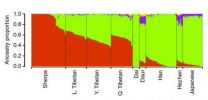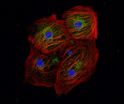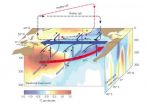(Press-News.org) Genetic adaptations for life at high elevations found in residents of the Tibetan plateau likely originated around 30,000 years ago in peoples related to contemporary Sherpa. These genes were passed on to more recent migrants from lower elevations via population mixing, and then amplified by natural selection in the modern Tibetan gene pool, according to a new study by scientists from the University of Chicago and Case Western Reserve University, published in Nature Communications on Feb. 10.
The transfer of beneficial mutations between human populations and selective enrichment of these genes in descendent generations represents a novel mechanism for adaptation to new environments.
"The Tibetan genome appears to arise from a mixture of two ancestral gene pools," said Anna Di Rienzo, PhD, professor of human genetics at the University of Chicago and corresponding author of the study. "One migrated early to high altitude and adapted to this environment. The other, which migrated more recently from low altitudes, acquired the advantageous alleles from the resident high-altitude population by interbreeding and forming what we refer to today as Tibetans."
High elevations are challenging for humans because of low oxygen levels but Tibetans are well adapted to life above 13,000 feet. Due to physiological traits such as relatively low hemoglobin concentrations at altitude, Tibetans have lower risk of complications, such as thrombosis, compared to short-term visitors from low altitude. Unique to Tibetans are variants of the EGLN1 and EPAS1 genes, key genes in the oxygen homeostasis system at all altitudes. These variants were hypothesized to have evolved around 3,000 years ago, a date which conflicts with much older archaeological evidence of human settlement in Tibet.
To shed light on the evolutionary origins of these gene variants, Di Rienzo and her team, led by first author Choongwon Jeong, graduate student at the University of Chicago, obtained genome-wide data from 69 Nepalese Sherpa, an ethnic group related to Tibetans. These were analyzed together with the genomes of 96 unrelated individuals from high-altitude regions of the Tibetan plateau, worldwide genomes from HapMap3 and the Human Genome Diversity Panel, as well as data from Indian, Central Asian and two Siberian populations, through multiple statistical methods and sophisticated software.
The researchers found that, on a genomic level, modern Tibetans appear to descend from populations related to modern Sherpa and Han Chinese. Tibetans carry a roughly even mixture of two ancestral genomes: one a high-altitude component shared with Sherpa and the other a low-altitude component shared with lowlander East Asians. The low-altitude component is found at low to nonexistent frequencies in modern Sherpa, and the high-altitude component is uncommon in lowlanders. This strongly suggested that the ancestor populations of Tibetans interbred and exchanged genes, a process known as genetic admixture.
Tracing the history of these ancestor groups through genome analysis, the team identified a population size split between Sherpa and lowland East Asians around 20,000 to 40,000 years ago, a range consistent with proposed archaeological, mitochondria DNA and Y chromosome evidence for an initial colonization of the Tibetan plateau around 30,000 years ago.
"This is a good example of evolution as a tinkerer," said Cynthia Beall, PhD, professor of anthropology at Case Western Reserve University and co-author on the study. "We see other examples of admixtures. Outside of Africa, most of us have Neanderthal genes—about 2 to 5 percent of our genome—and people today have some immune system genes from another ancient group called the Denisovans."
The team also found that Tibetans shared specific high-altitude component traits with Sherpa, such as the EGLN1 and EPAS1 gene variants, despite the significant amount of genome contribution from lowland East Asians. Further analysis revealed these adaptations were disproportionally enhanced in frequency in Tibetans after admixture, strong evidence of natural selection at play. This stands in contrast to existing models that propose selection works through new advantageous mutations or on existing variants becoming beneficial in a new environment.
"The chromosomal locations that are so important for Tibetans to live at high elevations are locations that have an excess of genetic ancestry from their high-altitude ancestral gene pool," Di Rienzo said. "This is a new tool we can use to identify advantageous alleles in Tibetans and other populations in the world that experienced this type of admixture and selection."
In addition to the EPAS1 and EGLN1 genes, the researchers discovered two other genes with a strong proportion of high-altitude genetic ancestry, HYOU1 and HMBS. The former is known to be up-regulated in response to low oxygen levels and the latter plays an important role in the production of heme, a major component of hemoglobin.
"There is a strong possibility that these genes are adaptations to high altitude," Di Rienzo adds. "They represent an example of how the ancestry-based approach used in this study will help make new discoveries about genetic adaptations."
INFORMATION:
The study "Admixture-facilitated genetic adaptations to high altitude in Tibet," was supported by the National Science Foundation. Additional authors include Gorka Alkorta-Aranburu, David B. Witonsky and Jonathan K. Pritchard from the University of Chicago, Buddha Basnyat from the Oxford University Clinical Research Unit at Patan Hospital in Nepal and Maniraj Neupane from the Mountain Medicine Society of Nepal.
The University of Chicago Medicine and Biological Sciences is one of the nation's leading academic medical institutions. It comprises the Pritzker School of Medicine, a top 10 medical school in the nation; the University of Chicago Biomedical Sciences Division; and the University of Chicago Medical Center, which recently opened the Center for Care and Discovery, a $700 million specialty medical facility. Twelve Nobel Prize winners in physiology or medicine have been affiliated with the University of Chicago Medicine.
Case Western Reserve University is one of the country's leading private research institutions. Located in Cleveland, we offer a unique combination of forward-thinking educational opportunities in an inspiring cultural setting. Our leading-edge faculty engage in teaching and research in a collaborative, hands-on environment. Our nationally recognized programs include arts and sciences, dental medicine, engineering, law, management, medicine, nursing and social work. About 4,200 undergraduate and 5,600 graduate students comprise our student body.
The genetic origins of high-altitude adaptations in Tibetans
Genome analysis reveals the origins of genetic adaptations for high altitude in Tibetans and suggests a novel mechanism for human adaptation
2014-02-10
ELSE PRESS RELEASES FROM THIS DATE:
Study involving twin sisters provides clues for battling aggressive cancers
2014-02-10
CINCINNATI – Analyzing the genomes of twin 3-year-old sisters – one healthy and one with aggressive leukemia – led an international team of researchers to identify a novel molecular target that could become a way to treat recurring and deadly malignancies.
Scientists in China and the United States report their findings online Feb. 9 in Nature Genetics. The study points to a molecular pathway involving a gene called SETD2, which can mutate in blood cells during a critical step as DNA is being transcribed and replicated.
The findings stem from the uniquely rare opportunity ...
Genome editing goes hi-fi
2014-02-10
SAN FRANCISCO, CA—February 9, 2014—Sometimes biology is cruel. Sometimes simply a one-letter change in the human genetic code is the difference between health and a deadly disease. But even though doctors and scientists have long studied disorders caused by these tiny changes, replicating them to study in human stem cells has proven challenging. But now, scientists at the Gladstone Institutes have found a way to efficiently edit the human genome one letter at a time—not only boosting researchers' ability to model human disease, but also paving the way for therapies that ...
Cochlear implants -- with no exterior hardware
2014-02-10
Cochlear implants — medical devices that electrically stimulate the auditory nerve — have granted at least limited hearing to hundreds of thousands of people worldwide who otherwise would be totally deaf. Existing versions of the device, however, require that a disk-shaped transmitter about an inch in diameter be affixed to the skull, with a wire snaking down to a joint microphone and power source that looks like an oversized hearing aid around the patient's ear.
Researchers at MIT's Microsystems Technology Laboratory (MTL), together with physicians from Harvard Medical ...
Scientists invent advanced approach to identify new drug candidates from genome sequence
2014-02-10
JUPITER, FL—February 9, 2014—In research that could ultimately lead to many new medicines, scientists from the Florida campus of The Scripps Research Institute (TSRI) have developed a potentially general approach to design drugs from genome sequence. As a proof of principle, they identified a highly potent compound that causes cancer cells to attack themselves and die.
"This is the first time therapeutic small molecules have been rationally designed from only an RNA sequence—something many doubted could be done," said Matthew Disney, PhD, an associate professor at TSRI ...
Fight or flight? Vocal cues help deer decide during mating season
2014-02-10
Previous studies have shown that male fallow deer, known as bucks, can call for a mate more than 3000 times per hour during the rut (peak of the mating season), and their efforts in calling, fighting and mating can leave them sounding hoarse.
In this new study, published today (10 February) in the journal Behavioral Ecology, scientists were able to gauge that fallow bucks listen to the sound quality of rival males' calls and evaluate how exhausted the caller is and whether they should fight or keep their distance.
"Fallow bucks are among the most impressive vocal athletes ...
Pacific trade winds stall global surface warming -- for now
2014-02-10
Heat stored in the western Pacific Ocean caused by an unprecedented strengthening of the equatorial trade winds appears to be largely responsible for the hiatus in surface warming observed over the past 13 years.
New research published today in the journal Nature Climate Change indicates that the dramatic acceleration in winds has invigorated the circulation of the Pacific Ocean, causing more heat to be taken out of the atmosphere and transferred into the subsurface ocean, while bringing cooler waters to the surface.
"Scientists have long suspected that extra ocean ...
Seven new genetic regions linked to type 2 diabetes
2014-02-10
Seven new genetic regions associated with type 2 diabetes have been identified in the largest study to date of the genetic basis of the disease.
DNA data was brought together from more than 48,000 patients and 139,000 healthy controls from four different ethnic groups. The research was conducted by an international consortium of investigators from 20 countries on four continents, co-led by investigators from Oxford University's Wellcome Trust Centre for Human Genetics.
The majority of such 'genome-wide association studies' have been done in populations with European ...
Optogenetic toolkit goes multicolor
2014-02-10
CAMBRIDGE, MA -- Optogenetics is a technique that allows scientists to control neurons' electrical activity with light by engineering them to express light-sensitive proteins. Within the past decade, it has become a very powerful tool for discovering the functions of different types of cells in the brain.
Most of these light-sensitive proteins, known as opsins, respond to light in the blue-green range. Now, a team led by MIT has discovered an opsin that is sensitive to red light, which allows researchers to independently control the activity of two populations of neurons ...
Clues to cancer pathogenesis found in cell-conditioned media
2014-02-10
Philadelphia, PA, February 10, 2014 – Primary effusion lymphoma (PEL) is a rare B-cell neoplasm distinguished by its tendency to spread along the thin serous membranes that line body cavities without infiltrating or destroying nearby tissue. By growing PEL cells in culture and analyzing the secretome (proteins secreted into cell-conditioned media), investigators have identified proteins that may explain PEL pathogenesis, its peculiar cell adhesion, and migration patterns. They also recognized related oncogenic pathways, thereby providing rationales for more individualized ...
Smoking linked with increased risk of most common type of breast cancer
2014-02-10
Young women who smoke and have been smoking a pack a day for a decade or more have a significantly increased risk of developing the most common type of breast cancer. That is the finding of an analysis published early online in Cancer, a peer-reviewed journal of the American Cancer Society. The study indicates that an increased risk of breast cancer may be another health risk incurred by young women who smoke.
The majority of recent studies evaluating the relationship between smoking and breast cancer risk among young women have found that smoking is linked with an increased ...
LAST 30 PRESS RELEASES:
Making lighter work of calculating fluid and heat flow
Normalizing blood sugar can halve heart attack risk
Lowering blood sugar cuts heart attack risk in people with prediabetes
Study links genetic variants to risk of blinding eye disease in premature infants
Non-opioid ‘pain sponge’ therapy halts cartilage degeneration and relieves chronic pain
AI can pick up cultural values by mimicking how kids learn
China’s ecological redlines offer fast track to 30 x 30 global conservation goal
Invisible indoor threats: emerging household contaminants and their growing risks to human health
Adding antibody treatment to chemo boosts outcomes for children with rare cancer
Germline pathogenic variants among women without a history of breast cancer
Tanning beds triple melanoma risk, potentially causing broad DNA damage
Unique bond identified as key to viral infection speed
Indoor tanning makes youthful skin much older on a genetic level
Mouse model sheds new light on the causes and potential solutions to human GI problems linked to muscular dystrophy
The Journal of Nuclear Medicine ahead-of-print tip sheet: December 12, 2025
Smarter tools for peering into the microscopic world
Applications open for funding to conduct research in the Kinsey Institute archives
Global measure underestimates the severity of food insecurity
Child survivors of critical illness are missing out on timely follow up care
Risk-based vs annual breast cancer screening / the WISDOM randomized clinical trial
University of Toronto launches Electric Vehicle Innovation Ontario to accelerate advanced EV technologies and build Canada’s innovation advantage
Early relapse predicts poor outcomes in aggressive blood cancer
American College of Lifestyle Medicine applauds two CMS models aligned with lifestyle medicine practice and reimbursement
Clinical trial finds cannabis use not a barrier to quitting nicotine vaping
Supplemental nutrition assistance program policies and food insecurity
Switching immune cells to “night mode” could limit damage after a heart attack, study suggests
URI-based Global RIghts Project report spotlights continued troubling trends in worldwide inhumane treatment
Neutrophils are less aggressive at night, explaining why nighttime heart attacks cause less damage than daytime events
Menopausal hormone therapy may not pose breast cancer risk for women with BRCA mutations
Mobile health tool may improve quality of life for adolescent and young adult breast cancer survivors
[Press-News.org] The genetic origins of high-altitude adaptations in TibetansGenome analysis reveals the origins of genetic adaptations for high altitude in Tibetans and suggests a novel mechanism for human adaptation






